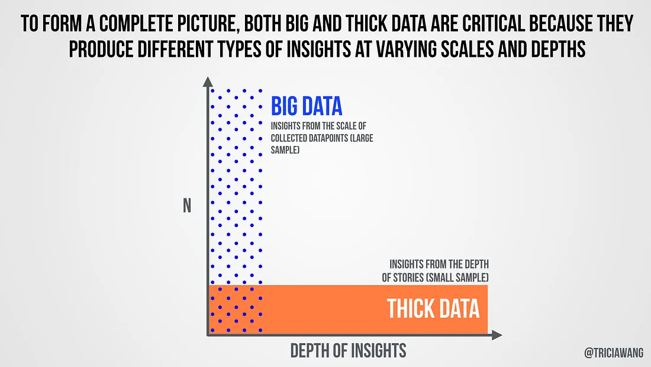Big Data + Thick Data: How did Netflix know we’d all become binge-watchers?”
Netflix revolutionised how we watch TV with binge-watching. This innovation didn’t happen through data alone— success depended on a critical combination of data types to understand both customer behaviour AND the motivations behind it. For businesses to achieve similar breakthroughs, they need a more nuanced approach to research and innovation that unlocks increased revenue and more in-depth consumer understanding. That’s where combining “big data” and “thick data” becomes vital. As we all know though, culture eats strategy for breakfast and this is not always easy.
Big Data
Big data, with its massive datasets, excels at identifying trends, patterns, and correlations. It’s great for questions like:
- What are our top-selling products?
- Which demographics are most engaged?
- During what times do website sales peak?
We constantly see this in our life. How does Amazon seem to know what you want next? Think about fraud at banks. How can banks know when to stop your credit card or call you to check if there was a potential fraud? Big data plays a huge role.
Big data is not only for large companies. With APIs from Amazon, Google and Microsoft any small business can explore using data analytics and algorithms to do the same.
A next gen example is Adelaide-based Fleet Space, which is using space innovation, AI and advanced geophysics to support mineral exploration, and is changing the way we find the green minerals we need for a sustainable future.
Thick data
“Thick data” dives deeper. Anthropologist Clifford Geertz described it as “establishing rapport, selecting informants, transcribing texts, taking genealogies, mapping fields, keeping a diary…” It helps us answer “why.” Why do customers buy this over that? What underlying motivations drive their choices? Thick data is your key to the kind of consumer insights that transform marketing campaigns.
Skills are key to making data work. A few tools that gives you a sense of how this can work are traditional ethnographic methods like:
- Participant Observation: Researchers immersing themselves in the environment they are studying (e.g., observing shoppers in a store, spending time in a workplace, etc.).
- In-depth Interviews: One-on-one conversations going beyond surface-level answers to uncover motivations, beliefs, and experiences.
- Focus Groups: While less ‘thick’ than individual interviews, these can still capture group dynamics and the social context around a topic.
In the era of digital, we can explore new tools like:
- Social Listening: Analysing online conversations (forums, reviews, social media) for sentiment, recurring themes, and the way people naturally express themselves. Tools like Brandwatch and Sprout Social streamline this.
- Digital Ethnography (Netnography): Adapting ethnographic techniques to online communities, observing behaviour within specific forums, social media groups, etc.
Combining Both

Say you are exploring new product development. Big data will help in market analysis, trend forecasting, and understanding the competitive landscape. Whereas, thick data can be great for focus groups, in-home product testing and observing customers interacting with prototypes to uncover more in-depth needs and pain points.
Coming back to Netflix, the streaming app noticed an intriguing big data trend: people binge-watching. But big data alone couldn’t fully explain it. Enter the anthropologist. By observing viewers in context, they discovered the social and emotional motivations: couples bonding, weekend relaxation, etc. This was the “aha” moment that changed Netflix’s game. Suddenly, it wasn’t just about delivering shows – it was about fulfilling needs. This led to smarter original content and the binge watching empire we know now.
Cultural Challenge
The elephant in the room as always will be cultural. Big Data and Thick Data by definition brings together different mindsets. For example:
- Big Data: Often associated with quantitative analysis, objectivity, and a focus on broad patterns. Teams working with big data may prioritise speed and efficiency.
- Thick Data: Rooted in qualitative methods, prioritising context, nuance, and individual stories. Teams focusing on thick data may value depth of understanding over rapid insights.
These approaches can seem at odds, leading to misunderstandings and undervaluing the other data type. This requires a range of solutions to manage it.
Next Steps
Embracing thick and big data isn’t just about better product development, it’s about a customer-obsessed mindset that drives growth. Are you ready to take the plunge? Consider:
- Can you pilot a small-scale ethnographic study?
- How could ‘thick data’ complement your existing analytics?
In the age of AI, it is obvious that all of this will be revolutionised with AI and how that fits into future innovation processes. Maybe a conversation for another day?
———
Suhit Anantula is an ecosystem and strategy design practitioner with experience across diverse industries. Their passion lies in applying design thinking methodologies to tackle complex challenges and create solutions that drive tangible results. Their approach blends user-centred insights, systems thinking, and a focus on measurable outcomes to deliver transformative change – whether optimising healthcare processes, reimagining government strategy & service delivery, or launching innovative new ventures. They are constantly exploring new ways to apply design thinking to address evolving business, societal, and environmental challenges, believing that design has the power to create a more positive and human-centred future.




